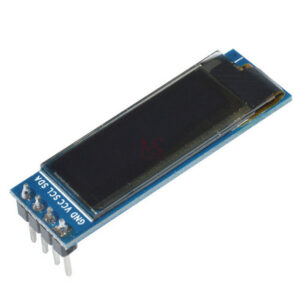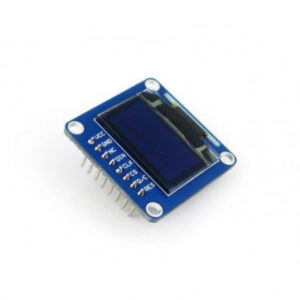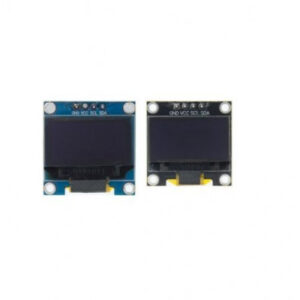OLED Display
Showing all 13 resultsSorted by latest
-
Display Devices, OLED Display
2.44 cm (0.96 Inch) I2C/IIC 128×64 OLED Display Module 4 Pin – White Color
 Display Devices, OLED Display
Display Devices, OLED Display2.44 cm (0.96 Inch) I2C/IIC 128×64 OLED Display Module 4 Pin – White Color
2.44 cm (0.96 Inch) I2C/IIC 128×64 OLED Display Module 4 Pin – White Color is a precise small, White OLED module which can be interfaced with any microcontroller using I2C/IIC protocol. It is having a resolution of 128×64.
OLED (Organic Light-Emitting Diode) is a self light-emitting technology composed of a thin, multi-layered organic film placed between an anode and cathode. In contrast to LCD technology, OLED does not require a backlight. OLED possesses high application potential for virtually all types of displays and is regarded as the ultimate technology for the next generation of flat-panel displays.
OLEDs basic structure consists of organic materials positioned between the cathode and the anode, which is composed of electric conductive transparent Indium Tin Oxide (ITO). The organic materials compose a multi-layered thin film, which includes the Hole Transporting Layer (HTL), Emission Layer (EML) and the Electron Transporting Layer (ETL). By applying the appropriate electric voltage, holes and electrons are injected into the EML from the anode and the cathode, respectively. The holes and electrons combine inside the EML to form excitons, after which electro luminescence occurs. The transfer material, emission layer material and choice of electrode are the key factors that determine the quality of OLED components.
SKU: n/a -
Display Devices, OLED Display
2.44 cm (0.96 inch) 128×64 OLED Display Module – SPI/I2C – 7 Pin
2.44 cm (0.96 inch) Blue OLED display module. The display module can be interfaced with any microcontroller using SPI/IIC protocols. It is having a resolution of 128×64 . The package includes display board,display, 7 pin male header presoldered to board.
OLED (Organic Light-Emitting Diode) is a self light-emitting technology composed of a thin, multi-layered organic film placed between an anode and cathode. In contrast to LCD technology, OLED does not require a backlight. OLED possesses high application potential for virtually all types of displays and is regarded as the ultimate technology for the next generation of flat-panel displays.
OLEDs basic structure consists of organic materials positioned between the cathode and the anode, which is composed of electric conductive transparent Indium Tin Oxide (ITO). The organic materials compose a multi-layered thin film, which includes the Hole Transporting Layer (HTL), Emission Layer (EML) and the Electron Transporting Layer (ETL). By applying the appropriate electric voltage, holes and electrons are injected into the EML from the anode and the cathode, respectively. The holes and electrons combine inside the EML to form excitons, after which electro luminescence occurs. The transfer material, emission layer material and choice of electrode are the key factors that determine the quality of OLED components.
SKU: n/a -
Display Devices, OLED Display
2.44 cm (0.96 inch) 128×64 OLED Display Module – 6 Pin
2.44 cm (0.96 inch) OLED Display Module is a precise small, White OLED module which can be interfaced with any microcontroller using SPI protocol. It is having a resolution of 128×64. The package includes display board, display, 6 pin male header.
OLED (Organic Light-Emitting Diode) is a self light-emitting technology composed of a thin, multi-layered organic film placed between an anode and cathode. In contrast to LCD technology, OLED does not require a backlight. OLED possesses high application potential for virtually all types of displays and is regarded as the ultimate technology for the next generation of flat-panel displays.
OLEDs basic structure consists of organic materials positioned between the cathode and the anode, which is composed of electric conductive transparent Indium Tin Oxide (ITO). The organic materials compose a multi-layered thin film, which includes the Hole Transporting Layer (HTL), Emission Layer (EML) and the Electron Transporting Layer (ETL). By applying the appropriate electric voltage, holes and electrons are injected into the EML from the anode and the cathode, respectively. The holes and electrons combine inside the EML to form excitons, after which electro luminescence occurs. The transfer material, emission layer material and choice of electrode are the key factors that determine the quality of OLED components.
It can be used with either an spi interface – selectable by soldering two jumpers on the again. The design is completely 5v-geared up, with an onboard regulator and constructed in raise converter. It’s easier than ever to connect immediately for your 3v or 5v microcontroller without having any type of stage shifter.
SKU: n/a -
Display Devices, OLED Display
Waveshare 2.44 cm (0.96 Inch) OLED Display (B) Module
This is a Waveshare 2.44 cm (0.96 Inch) OLED Display (B) module. It is a very high-contrast display with no backlight. It is perfect when you need an ultra-small display. This module supports SPI/I2C communication interfaces. It supports various hardware platforms such as Raspberry Pi/Jetson Nano/Arduino/STM32.
Comparing to LCD, OLED screens are way more competitive, which has a number of advantages such as high brightness, self-emission, high contrast ratio, slim outline, wide viewing angle, wide temperature range, and low power consumption. This module provides 3 kinds of driver interfaces; they are 3-wire SPI, 4-wire SPI, and I2C interface.
SKU: n/a -
Display Devices, OLED Display
Waveshare 1.5 inch 128×128 General OLED Display Module
This is a general 1.5inch diagonal OLED display Module from Waveshare, 128×128 pixels monochrome dot matrix display module with 16 grayscales, and embedded controller communicating via SPI or I2C interface.
It is perfect when you need an ultra-small display. Comparing to LCD, OLED screens are way more competitive, which has a number of advantages such as high brightness, self-emission, high contrast ratio, slim outline, wide viewing angle, wide temperature range, and low power consumption. It is compatible with any 3.3V-5V microcontroller, such as Arduino.
The characteristics of this display module are high brightness, self-emission, high contrast ratio, slim/thin outline, wide viewing angle, wide temperature range, and low power consumption.
SKU: n/a -
Display Devices, OLED Display
Waveshare 1.3 Inch OLED Display (B) Module
This is a Waveshare 1.3 Inch OLED Display (B) module. It is a very high-contrast display with no backlight. It is perfect when you need an ultra-small display. This module supports SPI/I2C communication interfaces. It supports various hardware platforms such as Raspberry Pi/Jetson Nano/Arduino/STM32.
Comparing to LCD, OLED screens are way more competitive, which has a number of advantages such as high brightness, self-emission, high contrast ratio, slim outline, wide viewing angle, wide temperature range, and low power consumption. This module provides 3 kinds of driver interfaces; they are 3-wire SPI, 4-wire SPI, and I2C interface.
SKU: n/a -
Display Devices, OLED Display
2.44 cm (0.96 Inch) I2C/IIC 128×64 OLED Display Module 4 Pin – Blue Color
 Display Devices, OLED Display
Display Devices, OLED Display2.44 cm (0.96 Inch) I2C/IIC 128×64 OLED Display Module 4 Pin – Blue Color
OLED (Organic Light-Emitting Diode) is a self light-emitting technology composed of a thin, multi-layered organic film placed between an anode and cathode. In contrast to LCD technology, OLED does not require a backlight. OLED possesses high application potential for virtually all types of displays and is regarded as the ultimate technology for the next generation of flat-panel display
This 2.44 cm (0.96 Inch) I2C/IIC 4pin OLED Display Module BLUE can be interfaced with any microcontroller using SPI/IIC/I2C protocols. It is having a resolution of 128×64. The package includes display board, display, 4 pin male header pre-soldered to board.
OLED monochrome 128×64 dot matrix display module. The characteristics of this display module are high brightness, self-emission, high contrast ratio, slim/thin outline, wide viewing angle, wide temperature range and low power consumption.
SKU: n/a -
Display Devices, OLED Display
2.32 cm (0.91 inch) I2C/IIC 128×32 Serial 4-Pin OLED Display Module – White
 Display Devices, OLED Display
Display Devices, OLED Display2.32 cm (0.91 inch) I2C/IIC 128×32 Serial 4-Pin OLED Display Module – White
This 0.91 I2C OLED Display is an OLED monochrome 12832 dot matrix display module with I2C Interface. It is perfect when you need an ultra-small display. The driver IC is SSD1306 with the I2C interface. Comparing to LCD, OLED screens are way more competitive, which has a number of advantages such as high brightness, self-emission, high contrast ratio, slim outline, wide viewing angle, wide temperature range, and low power consumption. It is compatible with any 3V-5V microcontroller, such as Arduino.
SKU: n/a -
Display Devices, OLED Display
1.3 Inch I2C IIC 128×64 OLED Display Module 4 Pin – White
This 1.3 I2C OLED Display is an OLED monochrome 128×64 dot matrix display module with I2C Interface. It is perfect when you need an ultra-small display. Comparing to LCD, OLED screens are way more competitive, which has a number of advantages such as high brightness, self-emission, high contrast ratio, slim outline, wide viewing angle, wide temperature range, and low power consumption. It is compatible with any 3.3V-5V microcontroller, such as Arduino.
SKU: n/a -
Display Devices, OLED Display
1.3 Inch I2C IIC 128×64 OLED Display Module 4 Pin – Blue
The 1.3 Inch 4 Pin OLED Display is a compact and bright 128×64 pixel blue display module compatible with Arduino and other microcontrollers via I2C or SPI interface. Perfect for displaying data, text, or graphics in embedded electronics projects.
SKU: n/a -
Display Devices, OLED Display
1.3 Inch 128×64 OLED Display Screen Module with SPI Serial Interface V2
 Display Devices, OLED Display
Display Devices, OLED Display1.3 Inch 128×64 OLED Display Screen Module with SPI Serial Interface V2
OLEDs are the future of displays, as they possess some of the greatest advantages over both conventional display technologies of LCDs and LEDs.
The most attractive thing about using the OLED displays is that they do not need a back-light like conventional LCD/LED screens. The organic material itself has a property known as Electroluminescence (EL), which causes the material to glow when stimulated by a current or an electric field. Best energy saving displays ever!!!
This 1.3 Inch 128×64 OLED Display Screen Module offers 128×64 pixel resolution. They are featuring much less thickness than LCD displays with good brightness and also produce better and true colors.
This OLED Display Module is very compact and will add a great ever user interface experience to your Arduino project. The connection of this display with Arduino is made through SPI interface.
The 1.3 Inch 128×64 OLED Display Screen Module produces blue text on black background with very good contrast when supplied with DC 2.8V supply. The OLED Display Modules also offers a very wide viewing angle of about greater than 160.
SKU: n/a

















